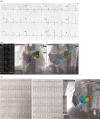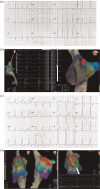Diagnosis and treatment of fetal and pediatric age patients (0-12 years) with Wolff-Parkinson-White syndrome and atrioventricular accessory pathways
- PMID: 37409656
- PMCID: PMC10836786
- DOI: 10.2459/JCM.0000000000001484
Diagnosis and treatment of fetal and pediatric age patients (0-12 years) with Wolff-Parkinson-White syndrome and atrioventricular accessory pathways
Abstract
Overt or concealed accessory pathways are the anatomic substrates of ventricular preexcitation (VP), Wolff-Parkinson-White syndrome (WPW) and paroxysmal supraventricular tachycardia (PSVT). These arrhythmias are commonly observed in pediatric age. PSVT may occur at any age, from fetus to adulthood, and its symptoms range from none to syncope or heart failure. VP too can range from no symptoms to sudden cardiac death. Therefore, these arrhythmias frequently need risk stratification, electrophysiologic study, drug or ablation treatment. In this review of the literature, recommendations are given for diagnosis and treatment of fetal and pediatric age (≤12 years) WPW, VP, PSVT, and criteria for sport participation.
Copyright © 2023 Italian Federation of Cardiology - I.F.C. All rights reserved.
Conflict of interest statement
There are no conflicts of interest.
Figures





References
-
- Cohen MI, Triedman JK, Cannon BC, Davis AM, Drago F, Janousek J, et al. . PACES/HRS expert consensus statement on the management of the asymptomatic young patient with a Wolff–Parkinson–White (WPW, ventricular preexcitation) electrocardiographic pattern. Heart Rhythm 2012; 9:1006–1024. - PubMed
-
- Gillette PC, Freed D, McNamara DG. A proposed autosomal dominant method of inheritance of the Wolff–Parkinson–White syndrome and supraventricular tachycardia. J Pediatr 1978; 93:257–258. - PubMed
-
- Chia BL, Yew FC, Chay SO, Tan AT. Familial Wolff–Parkinson–White syndrome. J Electrocardiol 1982; 15:195–198. - PubMed
-
- Gollob MH, Green MS, Tang AS, Gollob T, Karibe A, Ali Hassan AS, et al. . Identification of a gene responsible for familial Wolff–Parkinson–White syndrome. N Engl J Med 2001; 344:1823–1831. - PubMed
Publication types
MeSH terms
LinkOut - more resources
Full Text Sources

